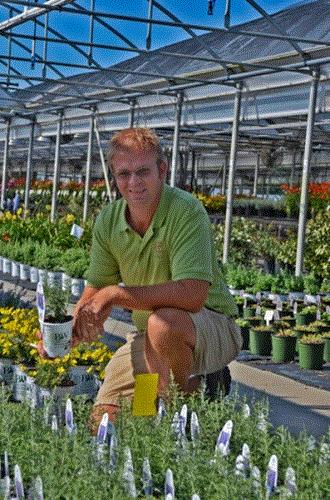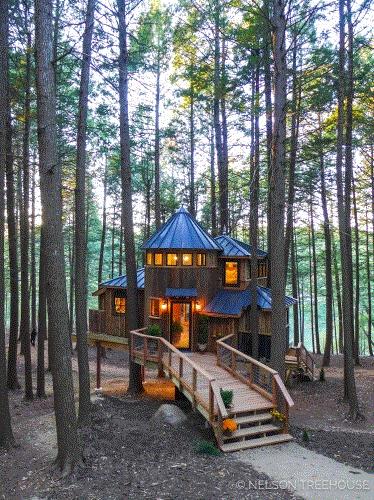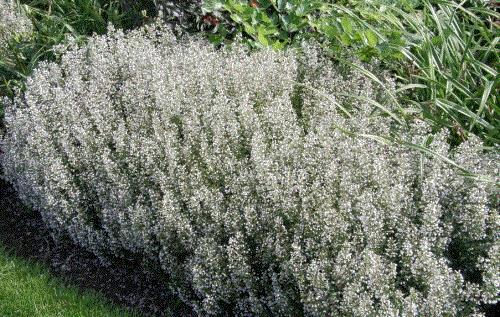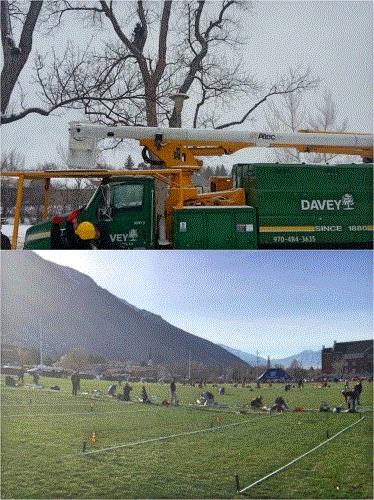Perennial Plants for Every Season
In a webinar that should be entertaining and educational, Ball Publishing will host Jeremy Windemuller (Trial Manager, Walters Gardens) on Valentine’s Day (that would be Wednesday, Febuary 14 for you non-romantics out there).
Jeremy will discuss how some perennial crops benefit from being grown during summer months, rather than during the spring or winter. In this webinar, you'll learn the benefits of summer planting, cultural requirements of summer-thriving taxa (including shade, water management and fertility), details on pinching and trimming, and preparation for winter/overwintering tips. Crops Jeremy will discuss include hosta, amsonia, baptisia, grasses and more.

You can sign up for the webinar here. And trust me, I've heard Jeremy speak and you’re certain to walk away dazed with new information!
Treehouses—WooHoo
When it comes to landscaping, I can’t think of a better fit than offering treehouse construction for a client. In fact, what better way to get kiddos out of the house than to lure them 20 to 30 ft. up in a tree?
So when my boss Jen Zurko sent me a story on Pete Nelson (owner of Nelson Treehouse & Supply in Fall City, Washington), I had to include it here! Pete was keynote speaker at the iLandscape show, which was held in Schaumburg, Illinois (west of Chicago), in January. But enough fluff, I’ll let Jen take it away …
I went on the first day of the iLandscapes show specifically to see the keynote speaker, Pete Nelson, owner of Nelson Treehouse & Supply in Fall City, Washington, and the star of Animal Planet’s “Treehouse Masters.” If you’ve never seen the show, imagine the lame rickety treehouse you had as a kid and times that by 1,000. The breadth of structures Pete and his team create in trees is unbelievable. (My 9-year-old daughter loves the show and wanted me to ask Pete if he could come and build us a treehouse. He chuckled when I told him that).
Pete talked a bit about how he got started building treehouses for a living, which for the first few years was a passion for him that he struggled to turn into a legitimate business. There were times where he and his wife Judy really struggled to put food on the table for them and their three young children. But his first coffee table book, and treehouses he built for friends and family started to garner some attention.

Now that is a treehouse, as in I want to live here treehouse! Photo courtesy of Nelson Treehouse & Supply.
As the business became more successful, Pete was approached by a company wanting to do a TV show, but he was skeptical. He didn’t want it to be a reality show “with all the fake drama.” His is a family business, with his wife, daughter, two sons and son-in-law involved, and he wanted it to show how much he loves his family and building treehouses. When Animal Planet approached him, he liked that they allowed him to create a show he and his family could be proud of.
I got to chat with Pete after his keynote and book signing, and asked him why he agreed to speak to a bunch of landscape contractors.
“My mission is to share good information with as many people as possible,” he said. “Although we mainly do private properties, we’ve been doing more with commercial properties and we’re working with landscape architects on these jobs.”
Pete knows that landscapers aren’t going to erect 300-sq. ft. treehouses on their job sites, but he’s hoping it gets them thinking about incorporating other viable forms of architecture, like wood, stone and other natural materials.
“People who are interested in the outdoors are good people,” said Pete. “And people love to be connected to the outdoors. I just want to open their eyes to adding something unique and unusual in the landscape.”

New Fertilizer Injector App Makes it Easy
Dr. Geoff Denny at Mississippi State (damn straight) University released a web-based app recently that takes the math out of fertilizer injector calculations. And considering we all know how horticulturists hate math worse than the dentist, it’s a blessing for us all. I also love the title of the app: "Fertilize It." Yes, it's that simple. No more math on the back of an envelope done on the tailgate of a truck.

Pictured here is the user interface, which is pretty darn simple, even for a college professor!
The app asks you for four pieces of information: desired concentration (PPM N); injector dilution ratio; fertilizer analysis (% N); and stock solution value. Enter the information, click calculate solution and voila—magic happens. It’s just as magical as a Disney movie.
Calamintha nepeta subsp. nepeta
I must admit, a friend (Paul Westervelt) posted on Facebook this week looking for sources of Calamintha nepeta subsp. nepeta and it brought back wonderful memories (not of Paul, although he's a fantabulous Virginia Tech alumni).
Rather, it was a flashback that resulted in this bit of nostalgia: As a young horticulturist around 13-14 years old, I used to frequent this plant at Boulderbrook Gardens in Dinwiddie, Virginia, and just sit beside it while it was in bloom, marveling at the humming variety of insect species that visited it while it was in bloom. And goodness did it bloom and bloom and bloom from early June to frost.

Not to be confused with catmint (Nepeta racemose), calamint (Calamintha nepeta subsp. nepeta) is vastly different than catnip (although both are in the Lamiaceae-mint family). Calamint is a bushy perennial that spreads moderately via rhizomes to form a mass of 18-in. tall foliage. For this reason, it's usually placed in more “wild” areas where plants are allowed to behave as plants should, not staying in a defined space. Blooms are white (buds lavender-pink) and somewhat fragrant, but understand that seed can spread around the garden. Foliage is also very fragrant and can be used to liven up a dinner party, although don’t put them in a mint julep because the taste is awful (in my humble opinion).
One thing to note is that Calamintha nepeta subsp. nepeta is a typical member of the Lamiaceae family. It prefers well-drained soils and will revolt if placed in wet areas or in shady spots. Throw it in full sun (maybe some late-day shade) and do your best to abuse it (except a little mulch—it likes to look good) and it will love you and where you placed it. Oh, I almost forgot—it does best in Zones 4b to 9, although it will grow into zone 10 and just not flower well.

Electronic Logging Devices & Spring 2018
I’ve received a boatload of questions regarding ELD since the beginning of the year regarding the “agricultural exemption” and how it applies to commercial ornamental producers. I must admit that I universally point to AmericanHort and say, “Ask Craig (Regelbrugge) and/or Tal (Coley).” Not because they're the smartest guys in the legislative-affairs room (they are, by the way), but because they advocate for our industry and can articulate well on where we currently stand. So, I thought it would be great to pass along the latest update from AmericanHort. Hence, I submit the quote below:
“AmericanHort submitted official comments to the Federal Motor Carrier Safety Administration (FMCSA) on January 18, advocating for nursery, greenhouse and Christmas tree farmers to be explicitly included in the agricultural exemption from the electronic logging device (ELD) mandate that went into effect on December 18, 2017. FMCSA is an agency within the Department of Transportation that regulates the trucking industry in the United States.
"FMCSA issued a request for public comment and notice of proposed regulatory guidance on December 20, 2017, as it's looking to clarify the applicability of the 'agricultural commodity' exemption. The agency is seeking to ensure consistent understanding of the exemption. The exemption states that the transportation of agricultural commodities within a 150-air mile radius from the source of the commodity is exempt from the ELD hours of service rules.
"However, there's little clarity in the rule as to what constitutes an agricultural commodity. The vague and problematic definition used in the legislation that created the mandate is causing significant confusion for several agricultural sectors, not just horticulture.
"Our official comment letter highlights other areas of federal statute and regulation that clearly and properly include and define our industry as being part of agriculture.
"It should be noted that the public comment period is ongoing, as FMCSA extended the deadline to February 20. Therefore, any person or organization can file comments to the federal docket until then.”
I would urge you to pay attention to the previous sentence. You still have time to comment. To do so, click here and search for docket number FMCSA-2017-0360 in the keyword box.

Speaking of Transportation and AmericanHort
AmericanHort has partnered with Dr. Charlie Hall (Texas A&M Agriculture Economist and straight shooter) to put on a series of six webinars that present "A Perspective on Profit Margins" I must admit, I just learned of the series myself and am so ashamed I failed to catch the first three live that I'll promptly go and put myself in time-out to think about what I've done (after I finish the newsletter). But even though the series is halfway over, you can still catch up on the first three (they're archived) and participate in the last three live.
The first three episodes cover an introduction and historical perspective to profit margins in our industry, how labor affects profit margin, and how energy and fertilizers have (and will continue to) affect margins. The next episode will investigate how transportation relates to profit margins and will air in late February.

You do need to be an AmericanHort member to take part in these webinars. If you’re not a member, this is a wonderful reason to join!

National Collegiate Landscape Competition 2018
Are you in the landscape contracting field and constantly find yourself complaining about a lack of employees (particularly folks with advanced degrees that can lead crews or serve in other management roles)? If not, consider yourself in the minority. If so, you may want to consider taking a trip to the National Collegiate Landscape Competition, which is being held at Alamance Community College on March 14-17, 2018.
Why travel from all across North America to Graham, North Carolina (outside Burlington), in March? Well, that’s easy … there will be 700-800 technical college and university students that are horticulturists-in-training. This is like the Mos Eisley of horticulture and I’m thinking you won’t find a larger wretched hive of horticultural scum and villainy (overt Star-Wars quote) in the galaxy. So book your trip now if you’re looking for employees. You can even set up a booth (check with event organizers for details) and speed-date (interview) dozens of students for both intern and full-time positions.

Neither snow (as seen above when Colorado State University hosted in 2015) or beautiful mornings (as seen below when BrighamYoung-Provo Hosted in 2017) shall stop these young professionals from showing off their skills!
If you can’t make it, you can still support your local technical college or university by donating your time or money to training students in their competition(s) (there are nearly 30 various skill tests) or simply being able to attend the competition. With close to 70 schools participating, chances are a local technical school or university with a horticulture program will be attending. And most rely on donations to pay for travel costs (because we all know students can’t afford travel costs).
And, yes, I will be there, leading The University of Georgia to yet another strong showing and serving as bail bondsman if needed. Look me up if you attend!

Our Wacky Wonderful World—Notes from the Edge of Sanity
There’s a new Ball Publishing guy in town and he covers the pests that drive you bonkers! That’s right, folks, Ball Publishing made the call to start a brand new enewsletter and dubbed Dr. JC Chong, an Associate Professor of Entomology at Clemson University, as the man to lead the charge. JC is an amazing guy who's full of energy, ideas and sarcasm—and who I bet you'll love to hear from. In fact, you can sign up for his newsletter here.

While he may seem like an unsuspecting guy, he's actually a superpestmanagement hero! Just wait till you read his newsletter ... and then you'll agree!
I’ve known JC for a long time, as we were PhD (piled higher and deeper) students together at The University of Georgia. He's gone on to develop one of the most impressive (university) pest management programs in the U.S., focusing on emerging insect pests and integrated pest management strategies for landscape contractors and nurseries. What I love about JC is that he "gets it" and by that I mean he connects with contractors and growers—and doesn’t just focus on research that won’t ever be commercially viable. He understands the economics, time requirements and product options needed to get the job done. I hope you give his new newsletter a shot. I doubt you'll be disappointed.

Live authentic,

Matthew Chappell
Editor-at-Large
Nursery & Landscape Insider
This has been received by 29,656 of the hardest-working horticulturists in show business!
If you're interested in reaching 29,656 (and growing) clients who eagerly await every Nursery & Landscape Insider and surely read every word, contact Kim Brown ASAP and she'll hook you up. And spread the word... let's get to 30,000 readers!